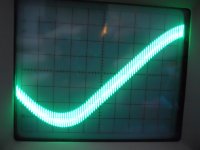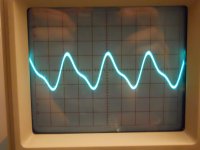Hi Everyone,
I just completed the first of two vintage Fisher model 100 mono amplifiers. They are essentially the last incarnation of the of the 80AZ.
I was doing a full electrical restoration as they were in rough shape and have seen alot of use and abuse. In fact, the second amp which I just started getting into, has gotten very very hot at one point. Some of the insulation from leads form the output transformer is charred and crumbing apart showing bare copper. Luckily i believe the transformers are ok.
More to come later as I plan to post a thread of the full rebuild.
Anyway, I got the first rebuilt unit up on the bench and it seems to work ok, however there is some HF noise way up at 100-200Khz range. I know these amps were notorious for having HF instability but it seems to be only noise. Not sure tho.
The odd part of this that is goes away with the volume knob at a very specific position. Also, If i shut off the amp while still driving it on my scope, the nose instantly goes away and the sine wave is pure again... until is dies out of course. It seems to me then that the noise is self induces by the AC in the amp, ...But at 100khZ???
The noise is seen around the 20mV range on my scope and can be tracked clearly when driving at around a watt. Much over a watt, the resolution on my screen makes the noise not visible anymore.
Any thoughts or suggestions are appreciated!
Regards,
Matt
I just completed the first of two vintage Fisher model 100 mono amplifiers. They are essentially the last incarnation of the of the 80AZ.
I was doing a full electrical restoration as they were in rough shape and have seen alot of use and abuse. In fact, the second amp which I just started getting into, has gotten very very hot at one point. Some of the insulation from leads form the output transformer is charred and crumbing apart showing bare copper. Luckily i believe the transformers are ok.
More to come later as I plan to post a thread of the full rebuild.
Anyway, I got the first rebuilt unit up on the bench and it seems to work ok, however there is some HF noise way up at 100-200Khz range. I know these amps were notorious for having HF instability but it seems to be only noise. Not sure tho.
The odd part of this that is goes away with the volume knob at a very specific position. Also, If i shut off the amp while still driving it on my scope, the nose instantly goes away and the sine wave is pure again... until is dies out of course. It seems to me then that the noise is self induces by the AC in the amp, ...But at 100khZ???
The noise is seen around the 20mV range on my scope and can be tracked clearly when driving at around a watt. Much over a watt, the resolution on my screen makes the noise not visible anymore.
Any thoughts or suggestions are appreciated!
Regards,
Matt
Attachments
Back on the bench this evening, I tried adding a 0.01uf cap on the shield of the input to ground to help shunt any noise to ground.
As expected this didn't help.
A few more observations:
-The "noise" is very periodic. My scope displays it perfectly without bouncing around which is why I don't think it is noise from the surroundings.
-Second, it take about 40 seconds for the noise to show up. Before then, when the amp is plenty warmed up to be active, there is no noise. I can get a few good seconds of clean output. After about 40 seconds, the oscillations show up immediately, it does not grow gradually. Literally nothing to full noise level.
Attached is a second photo of the noise. The first photo shows the noise riding on a 1KHz input.
As expected this didn't help.
A few more observations:
-The "noise" is very periodic. My scope displays it perfectly without bouncing around which is why I don't think it is noise from the surroundings.
-Second, it take about 40 seconds for the noise to show up. Before then, when the amp is plenty warmed up to be active, there is no noise. I can get a few good seconds of clean output. After about 40 seconds, the oscillations show up immediately, it does not grow gradually. Literally nothing to full noise level.
Attached is a second photo of the noise. The first photo shows the noise riding on a 1KHz input.
Attachments
Hi Matt,
Sounds like parasitic oscillations. That "appearing after 30 or 40 seconds" is fairly typical of that. When the tube gets up to full temperature and therefore it full operating transconductance (gm) it breaks into oscillation.
Check that every tube has a grid stop resistor and that when you did the rebuild the grid stop resistor body is hard up against the tube socket pin.
If the problem occurs at a particular volume setting and above, then the problem will most likely be in stages after the volume control up to and including the phase splitter.
If it occurs at a small range of volume settings then the problem is likely in the stage that the volume control feeds.
Where did you have the oscilloscope connected - Is that the trace from across the speaker connection?
Got a link to the schematic? That may help us make more specific suggestions.
Cheers,
Ian
Sounds like parasitic oscillations. That "appearing after 30 or 40 seconds" is fairly typical of that. When the tube gets up to full temperature and therefore it full operating transconductance (gm) it breaks into oscillation.
Check that every tube has a grid stop resistor and that when you did the rebuild the grid stop resistor body is hard up against the tube socket pin.
If the problem occurs at a particular volume setting and above, then the problem will most likely be in stages after the volume control up to and including the phase splitter.
If it occurs at a small range of volume settings then the problem is likely in the stage that the volume control feeds.
Where did you have the oscilloscope connected - Is that the trace from across the speaker connection?
Got a link to the schematic? That may help us make more specific suggestions.
Cheers,
Ian
Thanks for the help Ian.
Yes, the output was taken across a dummy load. Not sure why I haven't tracked the output of each stage to find the issue, but thats next.
I did however manage do dig out another pair of 6L6's I had lying around and the parasitics went away and the amp was performing well.
Is it odd, that output tubes would drastically change the result? Perhaps a lower transconductance than the first set of tubes? I can't imagine that a bad tube could cause oscillations.
I will put the old tubes back in and trace the circuit back to find the problematic stage.
Also I should note, there were much larger oscillations at another frequency, on top of the current oscillation issue, before adding in the compensation poles on the plate of the input and phase inverter stage. Adding these caps cleaned up these other oscillations.
As for grid stoppers, I added 1K on the 6L6 tubes as there were none in the original circuit (and schematic). This is odd considering the problematic history of these amps. Every incarnation of the AZ series were attempt to tame the HF oscillations.
I also increased the screen grid resistors from 68ohms to 120ohms.
see schematic:
Download the Fisher 100-AZ schematic for free - Hifi Manuals
Thanks!!
Yes, the output was taken across a dummy load. Not sure why I haven't tracked the output of each stage to find the issue, but thats next.
I did however manage do dig out another pair of 6L6's I had lying around and the parasitics went away and the amp was performing well.
Is it odd, that output tubes would drastically change the result? Perhaps a lower transconductance than the first set of tubes? I can't imagine that a bad tube could cause oscillations.
I will put the old tubes back in and trace the circuit back to find the problematic stage.
Also I should note, there were much larger oscillations at another frequency, on top of the current oscillation issue, before adding in the compensation poles on the plate of the input and phase inverter stage. Adding these caps cleaned up these other oscillations.
As for grid stoppers, I added 1K on the 6L6 tubes as there were none in the original circuit (and schematic). This is odd considering the problematic history of these amps. Every incarnation of the AZ series were attempt to tame the HF oscillations.
I also increased the screen grid resistors from 68ohms to 120ohms.
see schematic:
Download the Fisher 100-AZ schematic for free - Hifi Manuals
Thanks!!
Matt,
Sounds like you are on top of it.
If you have further problems then consider increasing those screen resistors, particularly if the amp is Ultralinear (I did'nt feel like signing up to be able to get hold of the schematic so I'm guessing). The screen resistors have a grid stop function in addition to helping to limit screen dissipation. In Ultralinear Amps they are required and counter intuitively, the better the output transformer the more they are required.
With Plitron torroidal output tranny driven by a quad of EL34 I found that while the 150 Ohm screen resistors were fine for Pentode and Triode Mode, when I went to Ultralinear I had to take them up to 1K to suppress parasitic oscillations.
Cheers,
Ian
Sounds like you are on top of it.
If you have further problems then consider increasing those screen resistors, particularly if the amp is Ultralinear (I did'nt feel like signing up to be able to get hold of the schematic so I'm guessing). The screen resistors have a grid stop function in addition to helping to limit screen dissipation. In Ultralinear Amps they are required and counter intuitively, the better the output transformer the more they are required.
With Plitron torroidal output tranny driven by a quad of EL34 I found that while the 150 Ohm screen resistors were fine for Pentode and Triode Mode, when I went to Ultralinear I had to take them up to 1K to suppress parasitic oscillations.
Cheers,
Ian
- Status
- This old topic is closed. If you want to reopen this topic, contact a moderator using the "Report Post" button.

